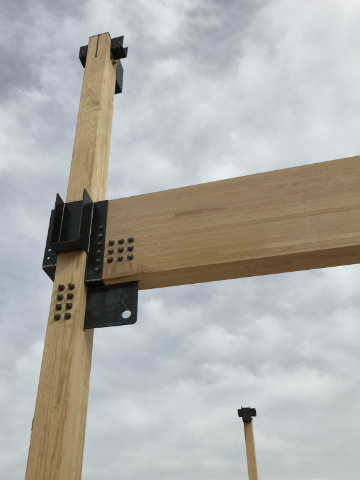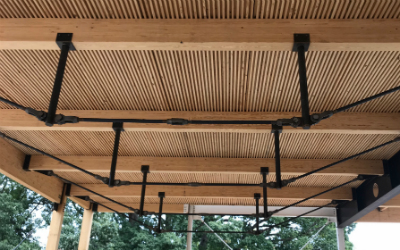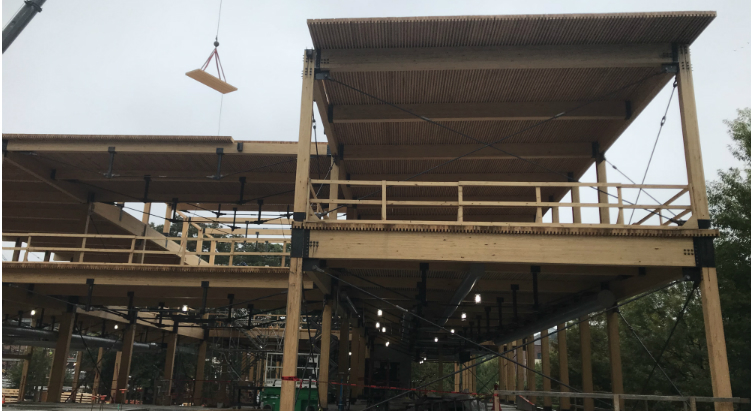Wood’s low embodied carbon content has benighted it as the structural material of choice for green buildings. And the growing popularity of structural timber is matched by an expanding array of methods and products. Here’s a quick cheat sheet to help navigate the modern realm of mass timber.
Engineered wood: A catch-all phrase used to describe a wide range of manufactured wood materials that may be used in buildings, as well as furniture and other products. Also known as composite wood, it is usually glued together to strengthen the final product or to enhance other characteristics. Engineered wood can range from structural timbers (such as beams and posts) to flat boards (such as plywood or oriented-strand board).
Forest Stewardship Council (FSC): The sustainable forest certification program preferred by green designers, builders and product manufacturers. FSC is an independent nonprofit that bases its standards on environmental, economic and social criteria, with an overriding interest in the health of forests. FSC is the only forest certification program fully recognized by both Leadership in Environmental Energy and Design (LEED) and Living Building Challenge (LBC) green building standards. Both wood and paper products may carry FSC certification.

Glue-laminated timber: An engineered wood product formed by binding together dimensional lumber. Multiple pieces of lumber bound together in such a fashion can carry heavier loads than similarly sized conventional timbers. Commonly referred to as “glulam,” glue-laminated timber may be exposed in the completed building or masked by finishes. The moisture resistant glue is a type of resin that must be applied via heat and pressure in the factory.
Lamstock: High-grade dimensional lumber (2x4s, 2x6s, etc.) that is manufactured for use in glue-laminated timber. Lamstock must have a low-moisture content and minimal defects, and must meet stringent strength requirements.
Red List compliant: Adhering to International Living Future Institute standards for toxic materials. Chemicals on the ILFI “Red List” are identified as polluting the environment, bio-accumulating in plants or animals, and/or harming construction and factory workers. Like all other materials in Living Building projects, glues and finish materials may not contain Red List chemicals.
Round timber: Trunks and large limbs that are harvested as logs and are finished for use in construction, but are not milled into “square” lumber. In certain cases, round timber may be hewn, sawn or planed. But the key is that it retains its natural shape and structural integrity. Advocates note that round timber can carry a heavier load than square timber of similar dimensions because its natural fibers are intact.
Sustainable Forestry Initiative (SFI): A sustainable forest certification program established with help from the timber industry as an alternative to the Forest Stewardship Council (see above). The SFI standard is less rigorous than FSC certification and has been criticized for potential conflicts of interest, because of support from industry. While SFI is deemed acceptable by some green building standards (including the internationally popular BREEAM platform), it isn’t recognized under the Living Building Challenge, and LEED only accepts SFI wood as part of an experimental exemption.
Timber framing: Technically refers to any structural approach that relies on a massive beams and posts rather than slender dimensional lumber framing. Typically refers to using traditional method of large beams and posts hewn or milled directly from tree trunks. Traditional methods relied heavily on mortise and tenon joints, as well as wooden pegs; modern methods rely on steel trusses and brackets.
Truss: A load-bearing element of a building’s structure composed of straight pieces of wood or metal, interconnected in the form of a triangle or multiple triangles. The truss enhances both the compressive and tensile strength of the element — in most cases allowing a beam or the truss itself to extend of a longer span of a floor, ceiling or roof than would otherwise be possible with the same material.

Queen post truss: A truss that contains two vertical posts with an open rectangle between them. A queen configuration is used to shorten the height of the truss. In houses, it often rises above the floor to create an attic space and at the same time to support the roof; in commercial buildings it may extend below a floor beam to extend the beam’s span.
Cross-laminated timber: Engineered wood panels composed of dimensional lumber glued together with the alternate layers oriented perpendicular to one another. A more recent innovation that glue-laminated timber, CLTs are more rigid. The concept is similar to plywood, but CLT is composed of thicker layers, enabling it to be used structurally.
Did I miss something? Please send suggested additions to this glossary by submitting a comment, and we’ll consider adding it?



I have been a strong proponent of timber construction for nearly 50 years. It has been some time since I delved into the evaluation of embodied energy in building materials but when I last looked into this I was disappointed to discover that the BTU value of materials when burned was included in the embodied energy value. This made no sense to me and many agreed that it unfairly skewed the evaluations. Is this still the case? Is the BTU value of wood when burned included in embodied energy?
fsc has zero to do with sustainability. fsc certifies tropical hardwoods that take thousands of years to reach a lumber producing size and many do not regenerate. author if that is how you and fsc define sustainable and renewable then we have some ocean front property to sell you in Indiana.
It is interesting that trusses can be wood or metal. My wife and I are considering making the ceiling in our living room higher so that it has vaulted ceilings instead of the eight-foot ceiling it is right now. We may reach out to a professional for structural recommendations and what type of timber they suggest.
I never knew that plywood would also be an engineered wood. If that makes it more affordable than traditional wood, then that seems like it would be a good option. If I build a house, that I’ll have to think about using engineered wood like plywood to see if I could build it for cheaper.